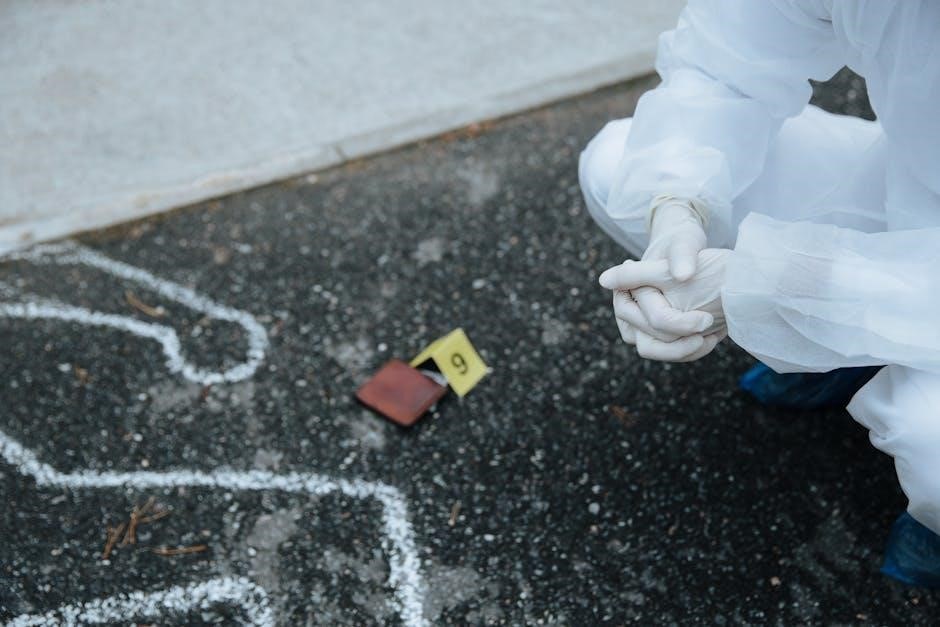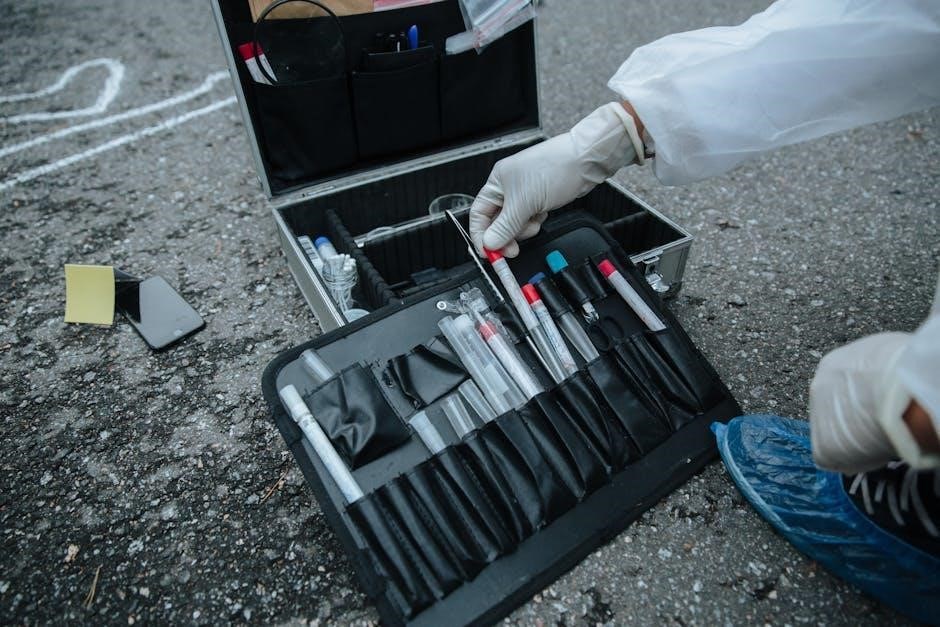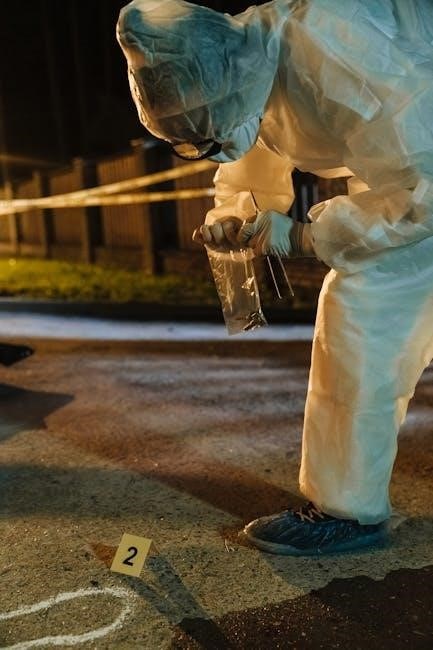Forensic Science: Fundamentals and Investigations provides a comprehensive overview of forensic principles, techniques, and applications. It covers crime scene investigation, evidence analysis, and courtroom testimony, balancing scientific theory with practical exercises for students and professionals alike.
The textbook emphasizes hands-on learning through lab activities, case studies, and digital tools like MindTap, ensuring a deep understanding of forensic science’s role in criminal justice and its impact on legal systems worldwide.
Overview of Forensic Science
Forensic Science: Fundamentals and Investigations serves as a foundational guide to understanding the principles and practices of forensic science. It introduces the scientific methods used to analyze evidence and solve crimes, emphasizing the importance of accuracy and reliability in legal investigations. The text explores the intersection of science and law, detailing how forensic experts collect, process, and interpret evidence. Key topics include crime scene investigation, physical evidence analysis, and the role of forensic scientists in court. The book is designed for students and professionals, offering a blend of theoretical knowledge and practical applications. By integrating real-world case studies and hands-on activities, it provides a comprehensive understanding of forensic science’s role in modern justice systems. This resource is essential for anyone seeking to grasp the fundamentals of forensic investigations and their significance in criminal justice.

History of Forensic Science

Forensic Science: Fundamentals and Investigations traces the evolution of forensic science from its early beginnings to modern advancements. The field originated in the late 19th century, with pioneers like Alphonse Bertillon and Francis Galton laying the groundwork for criminal identification through fingerprinting.
The 20th century saw significant milestones, such as the establishment of the first forensic laboratory in 1910 and the introduction of DNA analysis in the 1980s. These developments revolutionized crime solving, enabling scientists to link evidence to suspects with unprecedented accuracy.
Historical case studies in the text highlight how forensic techniques have improved over time, from basic observations to sophisticated technologies like digital forensics. This progression underscores the critical role of forensic science in justice systems worldwide, making it a cornerstone of modern criminal investigations. The book provides a detailed timeline of these advancements, illustrating how the field has grown to address emerging challenges in law enforcement.
Branches of Forensic Science
Forensic Science: Fundamentals and Investigations explores the diverse branches of forensic science, each specializing in unique areas of criminal investigation. These include forensic pathology, focusing on determining cause of death, and forensic toxicology, analyzing substances for drugs or poisons.
Forensic DNA analysis identifies individuals through genetic material, while trace evidence analysis examines hair, fibers, and other small-scale materials. Additionally, digital forensics investigates cybercrimes and recovers digital evidence.
Other branches like forensic anthropology and odontology focus on analyzing human remains and dental evidence, respectively. These specialized fields collectively provide a comprehensive approach to solving crimes, ensuring that all aspects of evidence are thoroughly examined. The textbook highlights how these branches integrate to support legal proceedings and justice systems worldwide.

Core Concepts of Forensic Science
Forensic Science: Fundamentals and Investigations emphasizes the integration of scientific principles with legal frameworks. It covers evidence collection, analysis, and interpretation, ensuring accuracy and reliability in criminal investigations and courtroom presentations.
The Scientific Method in Forensic Investigations
The scientific method is the cornerstone of forensic investigations, ensuring objectivity and reliability. It involves systematic steps: observation, hypothesis, experimentation, and conclusion. Forensic scientists apply these principles to analyze evidence, such as DNA, fingerprints, and trace materials, to reconstruct crimes and link suspects to crime scenes. By adhering to the scientific method, forensic experts maintain the integrity of their findings, which are critical for legal proceedings. This structured approach minimizes bias and ensures that evidence is interpreted accurately, supporting justice and accountability in criminal cases.
Types of Evidence in Forensic Science

Forensic science categorizes evidence into physical, biological, and digital types. Physical evidence includes fingerprints, footprints, and trace materials like fibers or gunshot residue. Biological evidence involves DNA, bloodstains, and bodily fluids, crucial for identifying individuals. Digital evidence encompasses data from devices, such as emails, texts, and surveillance footage. Each type of evidence is collected, analyzed, and compared to known samples or databases to establish connections between suspects, victims, and crime scenes. Proper handling and documentation of evidence are vital to ensure its admissibility in court. By examining these diverse forms of evidence, forensic scientists reconstruct crimes and provide critical insights for investigations. This systematic approach ensures that evidence is reliable and contributes to justice and accountability in criminal cases.
Crime Scene Investigation Fundamentals
Crime scene investigation is the systematic process of identifying, collecting, and analyzing physical evidence at a crime site. It begins with securing the area to prevent contamination and ensuring safety. Investigators document the scene using photographs, videos, and sketches to capture every detail. Physical evidence, such as fingerprints, footprints, and trace materials, is carefully collected and preserved. Biological evidence, like bloodstains or DNA samples, is also processed to aid in identifying suspects or victims. Proper documentation and chain of custody are critical to maintain the integrity of evidence for legal proceedings. The goal is to reconstruct events and link suspects to the crime through meticulous analysis. This fundamental process ensures that forensic scientists can derive actionable insights, making it a cornerstone of criminal investigations and justice systems worldwide.

Forensic Investigative Techniques
Forensic investigative techniques encompass fingerprint analysis, DNA profiling, and trace evidence examination. These methods aid in linking suspects to crimes, ensuring accurate and reliable results for legal proceedings and criminal investigations.
Fingerprint Analysis and Identification
Fingerprint analysis is a cornerstone of forensic science, leveraging the unique patterns found on individuals’ fingertips to establish identity. This method is pivotal in criminal investigations due to the uniqueness and permanence of fingerprints, which remain consistent throughout a person’s life unless altered by significant injury. The process involves several steps, including collection, where prints are lifted from surfaces using powders, chemicals, or digital scanners, followed by enhancement to clarify faint impressions. Once obtained, prints are categorized into three main types: arches, loops, and whorls, based on their ridge patterns. Identification occurs through a comparative analysis, where unknown prints are matched against known samples, often facilitated by automated systems like the Automated Fingerprint Identification System (AFIS). Despite its reliability, challenges such as partial prints or degraded samples can complicate the process. Emerging technologies, including 3D fingerprint reconstruction and biometric advancements, continue to enhance the accuracy and efficiency of this forensic tool, solidifying its role in law enforcement and legal proceedings.
DNA analysis has revolutionized forensic science by providing a highly accurate method for identifying individuals. This technique involves examining the unique genetic material found in biological samples such as blood, saliva, or tissue. The process begins with DNA extraction, followed by amplification using polymerase chain reaction (PCR) to generate sufficient material for analysis. Specific regions of the DNA, known as short tandem repeats (STRs), are then examined for their unique patterns. These STR profiles are compared against known samples, such as those from suspects or victims, to establish a match. DNA analysis is widely regarded for its reliability, with probabilities of mismatch often in the billions. However, challenges such as degraded DNA or mixed samples can complicate the process. Advances in technology, including rapid DNA testing and next-generation sequencing, are enhancing the speed and precision of DNA analysis. This method is not only crucial for solving crimes but also for exonerating the innocent, making it a cornerstone of modern forensic investigations. Trace evidence analysis is a critical component of forensic science, focusing on the examination of small, often overlooked materials found at crime scenes. These traces, such as hair, fibers, soil, paint, or glass, can provide significant links between suspects, victims, and crime scenes. The analysis typically involves microscopic examination and chemical testing to identify the origin and properties of the evidence. For instance, hair can be compared to known samples to determine species or individual origin, while fibers can be matched to specific fabrics. Soil and paint analysis can reveal geographical or vehicle-related connections. Trace evidence is often collected using specialized techniques to avoid contamination, ensuring its integrity for laboratory testing. Despite its miniature size, trace evidence can play a pivotal role in reconstructing crimes and establishing investigative leads. Advances in technology, such as improved microscopy and spectroscopy, have enhanced the precision of trace evidence analysis, making it a vital tool in forensic investigations. This method underscores the importance of meticulous crime scene processing and the scientific rigor applied to even the smallest details. Forensic science operates within a legal framework, ensuring evidence admissibility and ethical practices. It involves courtroom testimony, expert witness responsibilities, and compliance with legal standards to maintain justice and integrity in criminal investigations and trials. Forensic scientists play a pivotal role in court by providing expert testimony and interpretations of evidence. They must clearly communicate complex scientific findings to judges and jurors, ensuring accuracy and impartiality. Their testimony often determines case outcomes, making ethical conduct and adherence to legal standards crucial. Additionally, forensic scientists may be cross-examined, requiring them to defend their methods and conclusions rigorously. Proper documentation and understanding of legal procedures are essential to maintain credibility and reliability in court. The admissibility of forensic evidence in court is determined by its relevance, reliability, and compliance with legal standards. For evidence to be admitted, it must be material to the case and derived from credible, scientifically validated methods. Courts often apply standards like Frye or Daubert to assess the reliability of forensic techniques. Proper documentation, chain of custody, and expert testimony are critical to ensuring evidence is deemed admissible. Ethical considerations also play a role, as any compromise in methodology or integrity can lead to exclusion. The legal system’s acceptance of forensic evidence has evolved, with advancements in technology and increasing scrutiny of scientific rigor. Challenges arise with emerging or controversial methods, requiring courts to balance innovation with established norms. Ultimately, the admissibility process ensures that only trustworthy evidence informs legal decisions. Ethical considerations are paramount in forensic science to uphold justice, integrity, and public trust. Professionals must adhere to strict moral standards, avoiding bias and ensuring impartiality in evidence analysis. Misconduct, such as tampering with evidence or falsifying results, can undermine case outcomes and erode confidence in the legal system; Confidentiality is another critical aspect, as forensic scientists handle sensitive information that must remain protected. Transparency in methodologies and findings is essential to maintain credibility. Ethical dilemmas often arise in high-stakes cases, necessitating clear guidelines and accountability measures. Training and oversight are vital to fostering an ethical environment. By prioritizing ethical practices, forensic scientists contribute to fair and just legal proceedings, ensuring the integrity of their work and the trust of the public and the courts they serve. Advances in forensic science include digital forensics, DNA sequencing, and artificial intelligence. These technologies enhance crime scene analysis, evidence processing, and investigative accuracy, revolutionizing how crimes are solved and justice is served. Digital forensics involves the analysis of digital devices and data to investigate cybercrimes, such as hacking, fraud, and online harassment. It plays a critical role in modern forensic science, enabling experts to recover deleted files, trace online activities, and identify malicious software. Cybercrime investigations require specialized tools and techniques to extract and analyze evidence from computers, smartphones, and network systems. The field integrates legal frameworks with technical expertise to ensure the integrity of digital evidence for courtroom use. As cybercrimes grow more sophisticated, digital forensics continues to evolve, incorporating advancements in artificial intelligence and machine learning to improve the accuracy and speed of investigations. Educational resources, such as textbooks like Forensic Science: Fundamentals and Investigations, provide comprehensive guidance on these methods, preparing professionals to tackle the challenges of cybercrime effectively. The integration of digital forensics into forensic science underscores its importance in maintaining justice in the digital age. Emerging technologies are revolutionizing forensic science by enhancing accuracy, efficiency, and the ability to analyze complex evidence. Advances in artificial intelligence (AI) and machine learning enable faster and more precise analysis of large datasets, such as DNA profiles and fingerprint matching. Additionally, 3D printing is being used to recreate crime scenes and physical evidence, aiding investigators in understanding complex cases. Virtual reality (VR) and augmented reality (AR) are also being explored for reconstructing crime scenarios and training forensic professionals. These technologies, combined with advancements in biometrics and nanotechnology, are transforming traditional forensic methods. For instance, portable DNA analyzers now allow for rapid on-site testing, reducing the need for lab-based analysis. These innovations not only improve the reliability of forensic investigations but also help address challenges like data overload and resource limitations. By integrating these cutting-edge tools, forensic science is becoming more dynamic and effective in solving crimes and delivering justice.DNA Analysis in Forensic Science
Trace Evidence Analysis

Legal Aspects of Forensic Science
The Role of Forensic Scientists in Court

Admissibility of Forensic Evidence
Ethical Considerations in Forensic Science

Modern Advances in Forensic Science
Digital Forensics and Cybercrime Investigation
Emerging Technologies in Forensic Science

